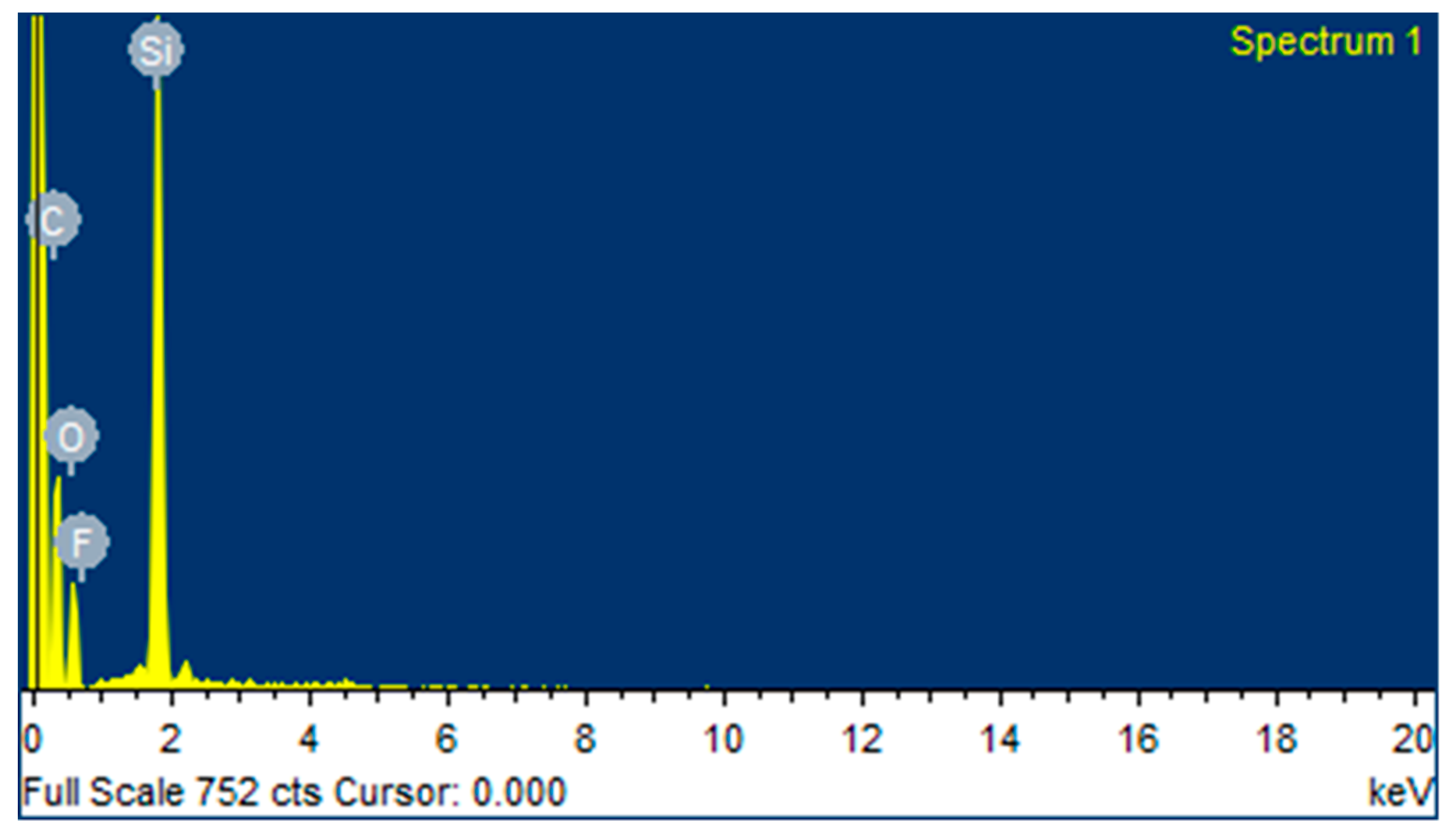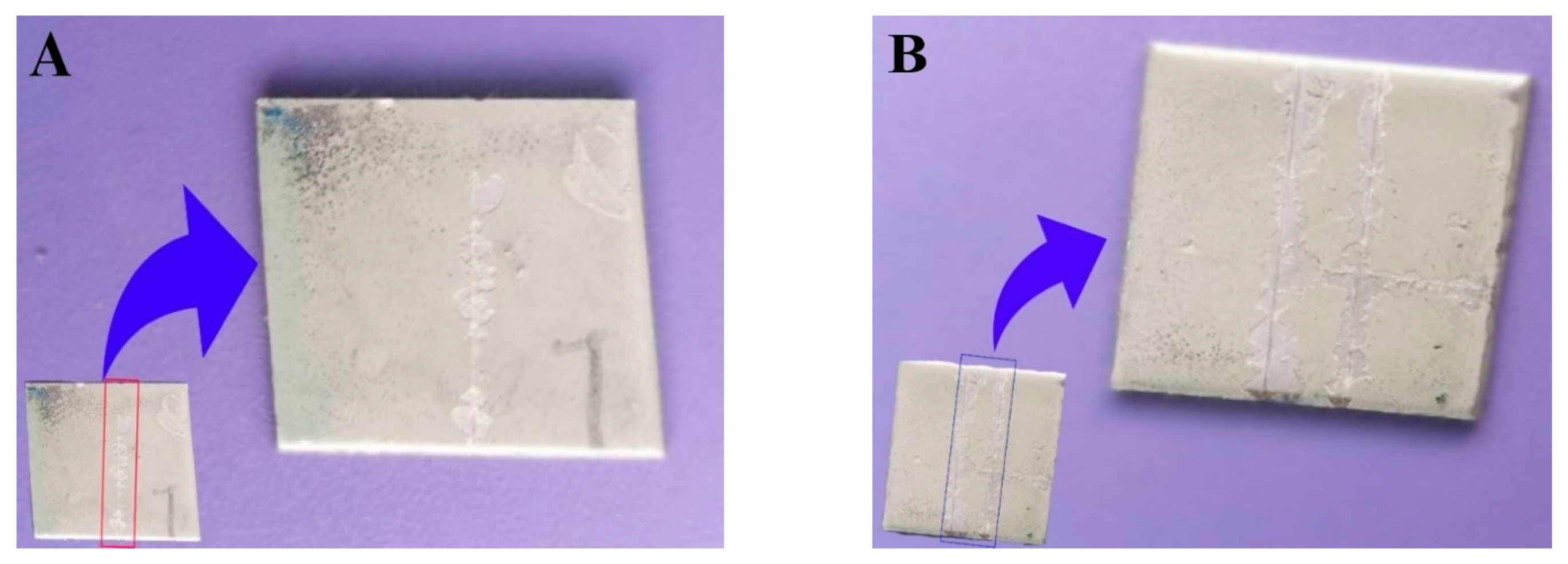Characterization of PTFE Film on 316L Stainless Steel Deposited through Spin Coating and Its Anticorrosion Performance in Multi Acidic Mediums
Abstract
:1. Introduction
2. Materials and Methods
2.1. Sample Preparation
2.2. Coating of PTFE on 316L SS
2.3. Characterization of PTFE Coating on 316L SS Substrate
2.4. Electrochemical Corrosion Test
2.5. Mechanical Testing
3. Results and Discussion
3.1. Characterization
3.2. Corrosion Measurement
3.3. Mechanical Testing
4. Conclusions
- A uniform PTFE coating was successfully deposited on 316L SS substrate by using the spin coating technique. Morphology results showed a smooth surface with no cracks or discontinuations in the coated substrate. SEM and electrochemical corrosion tests revealed the enhanced damage to the bare substrate with thick corrosive layers compared to the coated substrate, in which some surface pores or corrosive pits were detected on the surface, revealing more protected surface after the electrochemical test in the HCl and HNO3 medium. However, an increase in the concentration slightly affected the surface morphology by covering the corrosive pits.
- The comparison of the corrosion performance of PTFE-coated substrate with that of the bare 316L SS substrate in 13.05 M HCl solution at room temperature showed a PE of 96.7%, while in 9.58 M HNO3 solution the PE was 99.02%. This revealed that PTFE coating on SS provided superior corrosion resistance. The results showed a remarkable refinement in the corrosion resistance of PTFE coating by decreasing the corrosion rate and corrosion current density in both of the mediums. Thus, PTFE coating shows great potential to be used in harsh acidic industrial environments where high corrosion resistance is required.
- AFM results showed that the 316L SS and PTFE coating had an average surface roughness value of 26.3 nm and of 24.1 nm, respectively. EDS study confirmed the presence of C and F peaks in the coating.
- The micro Vickers hardness test revealed that the 316L SS substrate have a relatively high hardness value of 183 HV while the PTFE coating was found to be soft with a hardness value of 40 HV. Scratch tests revealed that it can bear a load up to 500 g, but after that a detectable scratch was observed. Thus, this work suggests the use of PTFE coatings in a severe, acidic environment where high corrosion resistance is required.
Author Contributions
Funding
Acknowledgments
Conflicts of Interest
References
- Hryniewicz, T.; Rokicki, R.; Rokosz, K. Corrosion characteristics of medical-grade AISI type 316L stainless steel surface after electropolishing in a magnetic field. Corrosion 2008, 64, 660–665. [Google Scholar] [CrossRef]
- Abdeen, D.H.; Atieh, M.A.; Merzougui, B.; Khalfaoui, W. Corrosion Evaluation of 316L Stainless Steel in CNT-Water Nanofluid: Effect of CNTs Loading. Materials 2019, 12, 1634. [Google Scholar] [CrossRef] [PubMed] [Green Version]
- Sekine, I.; Hatakeyama, S.; Nakazawa, Y. Corrosion behaviour of type 430 stainless steel in formic and acetic acids. Corros. Sci. 1987, 27, 275–288. [Google Scholar] [CrossRef]
- Sekine, I.; Senoo, K. The corrosion behaviour of SS 41 steel in formic and acetic acids. Corros. Sci. 1984, 24, 439–448. [Google Scholar] [CrossRef]
- Turnbull, A.; Ryan, M.; Willetts, A.; Zhou, S. Corrosion and electrochemical behaviour of 316L stainless steel in acetic acid solutions. Corros. Sci. 2003, 45, 1051–1072. [Google Scholar] [CrossRef]
- Henry, P.; Takadoum, J.; Berçot, P. Tribocorrosion of 316L stainless steel and TA6V4 alloy in H2SO4 media. Corros. Sci. 2009, 51, 1308–1314. [Google Scholar] [CrossRef]
- Mischler, S.; Ponthiaux, P.; du CEFRACOR, C.T. A round robin on combined electrochemical and friction tests on alumina/stainless steel contacts in sulphuric acid. Wear 2001, 248, 211–225. [Google Scholar] [CrossRef]
- Mesa, D.; Toro, A.; Sinatora, A.; Tschiptschin, A. The effect of testing temperature on corrosion–erosion resistance of martensitic stainless steels. Wear 2003, 255, 139–145. [Google Scholar] [CrossRef]
- Zhang, H.; Zhao, Y.; Jiang, Z. Effects of temperature on the corrosion behavior of 13Cr martensitic stainless steel during exposure to CO2 and Cl− environment. Mater. Lett. 2005, 59, 3370–3374. [Google Scholar] [CrossRef]
- Ziemniak, S.; Hanson, M. Corrosion behavior of 304 stainless steel in high temperature, hydrogenated water. Corros. Sci. 2002, 44, 2209–2230. [Google Scholar] [CrossRef] [Green Version]
- Pardo, A.; Merino, M.; Coy, A.; Viejo, F.; Arrabal, R.; Matykina, E. Pitting corrosion behaviour of austenitic stainless steels–combining effects of Mn and Mo additions. Corros. Sci. 2008, 50, 1796–1806. [Google Scholar] [CrossRef]
- Qvarfort, R. Some observations regarding the influence of molybdenum on the pitting corrosion resistance of stainless steels. Corros. Sci. 1998, 40, 215–223. [Google Scholar] [CrossRef]
- Huang, Y.; Wu, W.; Cong, S.; Ran, G.; Cen, D.; Li, N. Stress corrosion behaviors of 316LN stainless steel in a simulated PWR primary water environment. Materials 2018, 11, 1509. [Google Scholar] [CrossRef] [PubMed] [Green Version]
- Sarmento, V.; Schiavetto, M.; Hammer, P.; Benedetti, A.V.; Fugivara, C.S.; Suegama, P.; Pulcinelli, S.H.; Santilli, C.V. Corrosion protection of stainless steel by polysiloxane hybrid coatings prepared using the sol-gel process. Surf. Coat. Technol. 2010, 204, 2689–2701. [Google Scholar] [CrossRef]
- Shen, G.; Chen, Y.; Lin, C. Corrosion protection of 316 L stainless steel by a TiO2 nanoparticle coating prepared by sol-gel method. Thin Solid Films 2005, 489, 130–136. [Google Scholar] [CrossRef]
- Pech, D.; Steyer, P.; Millet, J.-P. Electrochemical behaviour enhancement of stainless steels by a SiO2 PACVD coating. Corros. Sci. 2008, 50, 1492–1497. [Google Scholar] [CrossRef]
- Li, C.; Bell, T. Corrosion properties of plasma nitrided AISI 410 martensitic stainless steel in 3.5% NaCl and 1% HCl aqueous solutions. Corros. Sci. 2006, 48, 2036–2049. [Google Scholar] [CrossRef]
- Misaelides, P.; Hatzidimitriou, A.; Noli, F.; Pogrebnjak, A.; Tyurin, Y.N.; Kosionidis, S. Preparation, characterization, and corrosion behavior of protective coatings on stainless steel samples deposited by plasma detonation techniques. Surf. Coat. Technol. 2004, 180, 290–296. [Google Scholar] [CrossRef]
- Kawakita, J.; Fukushima, T.; Kuroda, S.; Kodama, T. Corrosion behaviour of HVOF sprayed SUS316L stainless steel in seawater. Corros. Sci. 2002, 44, 2561–2581. [Google Scholar] [CrossRef]
- Marin, E.; Lanzutti, A.; Lekka, M.; Guzman, L.; Ensinger, W.; Fedrizzi, L. Chemical and mechanical characterization of TiO2/Al2O3 atomic layer depositions on AISI 316 L stainless steel. Surf. Coat. Technol. 2012, 211, 84–88. [Google Scholar] [CrossRef]
- Shan, C.; Hou, X.; Choy, K.-L. Corrosion resistance of TiO2 films grown on stainless steel by atomic layer deposition. Surf. Coat. Technol. 2008, 202, 2399–2402. [Google Scholar] [CrossRef]
- Lepule, M.L.; Obadele, B.A.; Andrews, A.; Olubambi, P.A. Corrosion and wear behaviour of ZrO2 modified NiTi coatings on AISI 316 stainless steel. Surf. Coat. Technol. 2015, 261, 21–27. [Google Scholar] [CrossRef]
- Bandar, A.-M.; Mongrain, R.; Irissou, E.; Yue, S. Improving the strength and corrosion resistance of 316L stainless steel for biomedical applications using cold spray. Surf. Coat. Technol. 2013, 216, 297–307. [Google Scholar]
- Ju, P.; Zuo, Y.; Tang, J.; Tang, Y.; Han, Z. The characteristics of a Pd–Ni/Pd–Cu double coating on 316L stainless steel and the corrosion resistance in stirred boiling acetic and formic acids mixture. Mater. Chem. Phys. 2014, 144, 263–271. [Google Scholar] [CrossRef]
- Hosseini, M.; Teymourinia, H.; Farzaneh, A.; Khameneh-asl, S. Evaluation of corrosion, mechanical and structural properties of new Ni–W–PCTFE nanocomposite coating. Surf. Coat. Technol. 2016, 298, 114–120. [Google Scholar] [CrossRef]
- Motalebi, A.; Nasr-Esfahani, M.; Ali, R.; Pourriahi, M. Improvement of corrosion performance of 316L stainless steel via PVTMS/henna thin film. Prog. Nat. Sci. Mater. Int. 2012, 22, 392–400. [Google Scholar] [CrossRef] [Green Version]
- Jafari, Y.; Ghoreishi, S.M.; Shabani-Nooshabadi, M. Electrochemical deposition and characterization of polyaniline-graphene nanocomposite films and its corrosion protection properties. J. Polym. Res. 2016, 23, 91. [Google Scholar] [CrossRef]
- Shabani-Nooshabadi, M.; Ghoreishi, S.M.; Jafari, Y.; Kashanizadeh, N. Electrodeposition of polyaniline-montmorrilonite nanocomposite coatings on 316L stainless steel for corrosion prevention. J. Polym. Res. 2014, 21, 416. [Google Scholar] [CrossRef]
- Ates, M.; Kalender, O.; Topkaya, E.; Kamer, L. Polyaniline and polypyrrole/TiO2 nanocomposite coatings on Al1050: Electrosynthesis, characterization and their corrosion protection ability in saltwater media. Iran. Polym. J. 2015, 24, 607–619. [Google Scholar] [CrossRef]
- Balaji, R.; Pushpavanam, M.; Kumar, K.Y.; Subramanian, K. Electrodeposition of bronze–PTFE composite coatings and study on their tribological characteristics. Surf. Coat. Technol. 2006, 201, 3205–3211. [Google Scholar] [CrossRef]
- Burris, D.L.; Sawyer, W.G. Improved wear resistance in alumina-PTFE nanocomposites with irregular shaped nanoparticles. Wear 2006, 260, 915–918. [Google Scholar] [CrossRef]
- Hedley, J. Electroless nickel/PTFE composite coatings. Met. Finish. 1987, 85, 51–53. [Google Scholar]
- Unal, H.; Mimaroglu, A.; Kadıoglu, U.; Ekiz, H. Sliding friction and wear behaviour of polytetrafluoroethylene and its composites under dry conditions. Mater. Des. 2004, 25, 239–245. [Google Scholar] [CrossRef]
- Shabani-Nooshabadi, M.; Mollahoseiny, M.; Jafari, Y. Electropolymerized coatings of polyaniline on copper by using the galvanostatic method and their corrosion protection performance in HCl medium. Surf. Interface Anal. 2014, 46, 472–479. [Google Scholar] [CrossRef]
- Das, B.; Konwar, U.; Mandal, M.; Karak, N. Sunflower oil based biodegradable hyperbranched polyurethane as a thin film material. Ind. Crops Prod. 2013, 44, 396–404. [Google Scholar] [CrossRef]
- Maqsood, N. PTFE thin film coating on 316l stainless steel for corrosion protection in acidic environment. J. Eng. Appl. Sci. 2017, 36. [Google Scholar]
- Wan, Y.; Yu, Y.; Cao, L.; Zhang, M.; Gao, J.; Qi, C. Corrosion and tribological performance of PTFE-coated electroless nickel boron coatings. Surf. Coat. Technol. 2016, 307, 316–323. [Google Scholar] [CrossRef]
- Sangeetha, S.; Kalaignan, G.P.; Anthuvan, J.T. Pulse electrodeposition of self-lubricating Ni–W/PTFE nanocomposite coatings on mild steel surface. Appl. Surf. Sci. 2015, 359, 412–419. [Google Scholar] [CrossRef]
- Zhang, R.; Zhao, J.; Liang, J. A novel multifunctional PTFE/PEO composite coating prepared by one-step method. Surf. Coat. Technol. 2016, 299, 90–95. [Google Scholar] [CrossRef]
- Conte, M.; Igartua, A. Study of PTFE composites tribological behavior. Wear 2012, 296, 568–574. [Google Scholar] [CrossRef]











| Elements | C | Mn | P | S | Si | Cr | Ni | Mo | Fe |
|---|---|---|---|---|---|---|---|---|---|
| Compositions (wt.%) | 0.03 | 2.00 | 0.045 | 0.03 | 0.75 | 17.4 | 12.58 | 2.28 | Bal. |
| Elements | C | O | F | Si |
|---|---|---|---|---|
| Compositions (wt.%) | 21.25 | 13.70 | 10.23 | 54.82 |
| Specimen | HCl Concentration | Ecorr (mV) | icorr (µA/cm2) | C.R (mpy) |
|---|---|---|---|---|
| 316L SS | 13.05 M | −502.559 | 80.76 | 29.55735 |
| PTFE coating | 6.5 M | −424.659 | 1.065 | 0.3896725 |
| PTFE coating | 9.79 M | −417.659 | 1.791 | 0.655474 |
| PTFE coating | 13.05 M | −431.559 | 2.672 | 0.9779258 |
| Specimen | HNO3 Concentration | Ecorr (mV) | icorr (µA/cm2) | C.R (mpy) |
|---|---|---|---|---|
| 316L SS | 9.58 M | 26.80 | 1480 | 684.8 |
| PTFE coating | 4.79 M | 67.60 | 8.840 | 4.080 |
| PTFE coating | 7.19 M | 71.30 | 9.010 | 4.157 |
| PTFE coating | 9.58 M | −20.80 | 14.50 | 6.676 |
© 2020 by the authors. Licensee MDPI, Basel, Switzerland. This article is an open access article distributed under the terms and conditions of the Creative Commons Attribution (CC BY) license (http://creativecommons.org/licenses/by/4.0/).
Share and Cite
Akram, W.; Farhan Rafique, A.; Maqsood, N.; Khan, A.; Badshah, S.; Khan, R.U. Characterization of PTFE Film on 316L Stainless Steel Deposited through Spin Coating and Its Anticorrosion Performance in Multi Acidic Mediums. Materials 2020, 13, 388. https://doi.org/10.3390/ma13020388
Akram W, Farhan Rafique A, Maqsood N, Khan A, Badshah S, Khan RU. Characterization of PTFE Film on 316L Stainless Steel Deposited through Spin Coating and Its Anticorrosion Performance in Multi Acidic Mediums. Materials. 2020; 13(2):388. https://doi.org/10.3390/ma13020388
Chicago/Turabian StyleAkram, Waseem, Amer Farhan Rafique, Nabeel Maqsood, Afzal Khan, Saeed Badshah, and Rafi Ullah Khan. 2020. "Characterization of PTFE Film on 316L Stainless Steel Deposited through Spin Coating and Its Anticorrosion Performance in Multi Acidic Mediums" Materials 13, no. 2: 388. https://doi.org/10.3390/ma13020388






